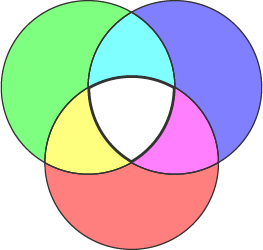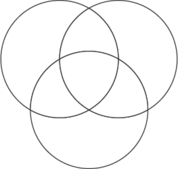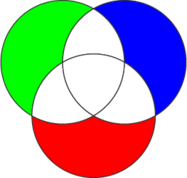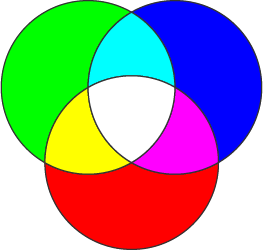Over the last decade there has been an increase of convincing evidence of the effectiveness of implicit motor learning and procedural processes for learning (even for early stages of learning), instead of learning in a verbal declarative way. The results of the current research agree with this view, suggesting that an emphasis on implicit procedural learning could also benefit musicians. This would imply that musicians should shift their focus from the outcome of their music-making (perfection and success) to their musical intention (expression). This is not to say excellence, perfection and success are not important, but rather, that they are side effects of being totally engaged in the activity of music-making.
A theme that emerged during this research was the importance of connectivity. First year students, quoted in the introduction of this dissertation, mentioned that playing music made them feel connected – with themselves, with music and with each other. Practices that connect the senses and engage more areas of the brain (i.e. vivid multimodal methods) and putatively reduce cognitive load (imagery versus verbal information) should be encouraged. The present research shows that interpersonal connectivity within ensembles also benefits from using musical imagery and external focus in general. Presumably enhanced connectivity in individuals and within ensembles would also have the effect of better communication with the audience.
This chapter outlines a holistic approach to motor learning and motor control for musicians that reflects the findings of the current research. Implications and recommendations for how to train musicians are outlined, and the role of the conservatoire is discussed.
Figure 9.1 illustrates how body, mind and emotion can interact in an optimal way to support complex motor learning. Rather than being used for thinking about, analysing and steering the body’s movements (i.e. internal focus), the mind is focussing on the intended musical effect. Musical effect is informed not just by imagining sound, but mood and emotion. In this way emotion is informing the mind. The minds’ focus is, in turn, informing the body’s implicit mechanisms so that learning or performance can take place without too much disturbance of analytic thought and judgements. The space in the centre, where body, mind and emotion are all present, represents a balanced centre where a state of “flow” or total engagement can be achieved.
A Holistic Approach to Learning and Performing
Music-making is a complex multi-modal activity (Altenmüller, 2008) and needs a complex multi-modal approach (Schaefer, 2017). There is still not enough knowledge and adequate explanation of the mechanisms behind motor learning and motor control: “It is time the motor learning field developed a new theory for motor learning” (Schmidt, 2003, p. 373). Wulf and Lewthwaite’s OPTIMAL theory of motor learning seems to offer a more comprehensive explanation about how complex movements are learned and performed than do earlier theories. The current research suggests that music-making could be viewed as involving a self-organising system that can benefit from the use of external focus. Applying an external focus reduces cognitive control and thus the degrees of freedom problem is optimized automatically by the motor system without requiring additional cognitive resources.
The question for a musician is not “How does it work?” but rather: “What do I need to do in order for it to work?” A musician does not need to understand the workings of his muscles, nerves and neurons or to be instructed what movements to make (Masters, 2012; Wulf, 2007; 2013; Wulf & Mornell, 2008) but rather have an exploratory and holistic approach to practicing and performing in which mind, body and emotions cooperate to get the best results. Ideally, the mind is concerned with external focus on musical elements (rather than with things like analysis, judgement, internal focus, comparison, worry about consequences, and distraction) in order to allow the body’s implicit mechanisms to learn or remember the appropriate movement. External focus – or focussing on musical intention – can be informed by the emotions – i.e. the performer’s own emotions (connected with the music) or the emotions embedded in the music.
Figure 9.1 expands the concepts illustrated in Figure 0.4 from the introduction, showing a paradigm where the musician himself is the instrument, and highlights the important role of emotion in music-making. This dissertation opened with an example of the discrepancy between how conservatoire music students view their reasons for playing music and the way they approach practice. The theoretical chapters highlighted theories and research that suggest that complex motor skills are best learned implicitly and that external focus can facilitate this process. The main research question starts by asking how we can characterise external focus for musicians. External focus for musicians is music: focussing on expression and communicating through sound. Focussing externally can involve using auditory musical imagery, metaphors, gestures, a narrative, or focussing on kinaesthetic elements of the desired goal. A rich multimodal approach is likely to get the best results.
The conclusion of this dissertation is that we need to teach musicians how to explore expression, rather than striving to understand and consciously control the mechanics of music-making. Technique and expression need not be separated and dissected, but rather can inform each other in order to achieve “ideal music”.
The Three Stages of Learning Reformulated
In Chapter 1, motor learning was described in three stages: the “cognitive/declarative” stage, the “associative” stage, and the “autonomous” stage. To summarise the mainstream view: the early stage requires cognitive declarative processes in order to understand the skill, and gradually through the learning process automaticity is achieved, until it would be no longer necessary to control the movements consciously. In the light of the research presented here, the stages of learning could be considered in a way in which external focus plays a prominent part in every stage of the journey.
The Early Stage involves understanding the task by formulating intentions. Intentions can be formulated through making decisions about what is to be learned and what the desired results should sound and feel like, as well as developing a sense of the meaning behind and the emotions connected with the piece (if one is learning repertoire). A piece of music would be played slowly or in small chunks. Strategies can then be designed for achieving the intended goal / goals. The early stage can also involve organisation – taking care that everything that is needed is available and organised. Cognitive, declarative processes are used for organising and making learning strategies and goals rather than steering movements.
The Middle Stage is characterised by exploration. This stage involves creating an environment for exploration by choosing tools and methods that enhance getting to know the skill or piece better by developing sensory awareness and exploring musical intention – e.g. by using external focus tools or by improvisation. Important in this stage is also the development and use of self-regulation and reflection. Sections of music would be gradually chained together.
The Final Stage is about finding the “flow state”. When a piece or skill is learned, a musician needs to practice trust and the ability to focus on musical details as well as the larger picture. This is acheived by relying on using rich musical imagery and distal external focus during the whole piece. The goal of practice at this stage is on staying engaged (in focus) as well as practicing recovery (how to stay on track after an error or distraction).
Training Performing Musicians
The main implication of the current research is that clear musical intention is vital to music-making and is a pre-requisite for a reliable technique, and that musical intention can and should be trained. The ability to imagine clearly and vividly improves with practice. Asking the question “What do I want to say here?” is very different from trying to solve a technical problem and results in an explorative, procedural process. An example would be to use “varied practice” (as described in Chapter 3) which can produce a much more nuanced (and musically complex) result than a purely technical approach. The “self organisation” that accompanies exploratory practice will help to achieve goals more effectively and efficiently than will relying on declarative processes. Music then informs technique. Although one of the main goals of a musician is to play accurately, accuracy is better achieved by focussing on musical intention. A clear musical image includes the right notes, rhythm and dynamics. Thus accuracy and facility is a side effect of external focus.
Methods such as APT, varied practice and improvisation are but a few of the tools that can enhance learning by exploring expression and using external focus. These and other methods are described in detail in the publication Quality Practice presented at the end of the current thesis. The goal of practice should be to find ways to enhance engagement and motivation and to find the right focus to achieve concrete goals (see Quality Practice for a detailed explanation), and to practice intention. Rather than giving answers in the form of instructions, rules and information that can lead to cognitive overload, teachers could ask more questions and offer suggestions and encouragement to help students explore and find their own solutions and their own voice. The methods described above encourage autonomy, as the students have to find their own interpretations and not just follow instructions or mimic the teacher. The practice room and the teaching studio should be a place for "learning to learn".
External focus is not a new concept. It is a new term for what good musicians have always done: focussing on music and the meaning embedded within the music. Studies like those of Trusheim (1991) and Buma et al. (2014) imply that successful musicians rely on external focus and audiation to perform and to prepare performances. Mornell & Wulf’s study (2019) supports this assumption. What could be developed, however, is that the use of external focus could be more explicit (i.e. not implicit) and prominent in teaching and in practicing – that we develop methods and approaches that encourage external focus in learning and teaching and during practice and rehearsal, as well as developing explicit ways to rely on external focus during performance – even when under pressure.
The Role of Conservatoires
One of the main tasks of a conservatoire is to teach musicians how to practice (as mentioned by Jørgensen in the introduction of the current thesis) (Jørgensen, 2009). Teaching musicians how to practice needs to be embedded in the curriculum, and main subject teachers themselves need to be informed about practice methods and strategies, and even current theories and research on learning and performance.
Conservatoires could shift their goals from producing technically finished performers to training expert learners and musicians who can express themselves clearly, and who are equipped to continue and steer their own development. One-to-one lessons can be enhanced by the creation of learning environments that offer rich, holistic, multimodal ways of practicing, preparing performances, rehearsing and performing. Projects similar to Projects Two and Three described in the present research can be implemented to encourage procedural learning where musicians are engaged in exploration rather than in problem solving. A “Study Lab Project” carried out by Bakker, Kouwenhoven, Schuijer, and Oudejans (2016) bears some similarity with Project Three in the current study. The researchers created an intensive learning environment for music students to use techniques connected with deliberate practice, external focus, use of imagery, and performance preparation. The emphasis was on quality rather than on quantity of practice. The project reported positive reactions from the students and suggests the importance of creating environments and opportunities within conservatoires to help musicians explore and develop new ways to practice and prepare their performances.
The main elements behind effective practice and projects are outlined in Wulf and Lewthwaite’s OPTIMAL theory – autonomy, enhanced expectancies and external focus. In a staff development seminar at the Royal Conservatoire of The Hague, which took place in March 2018, the researcher explained to 25 teachers (including both instrumental and theory teachers, as well as two dance teachers) the theory behind implicit learning and the OPTIMAL theory, and then asked them what the implications and applications could be for their teaching.
On the subject of implicit motor learning the responses from the teachers included the following implications and applications: “Learning through modelling”; “Look for musical and expressive terms rather than technical ones”; “Avoid verbal and technical instructions”; “Learn to accept mistakes”; "Learn to let go of needing to intellectually understand or control everything”. The conclusion was: Instead of asking “How does it work?”, a musician needs to ask “What do I need to do in order for it to work?”
The theme of autonomy generated the following responses: “Ask questions”; “Limit feedback and let the student lead the feedback”; “Encourage the students to look for their own musical ideas”; “Check what the student wants to learn”; “Let the student choose repertoire”; “Help the student feel ownership of their process and not just focus on the result (or grade)”. The conclusion was: Students need to develop agency by realising that they are responsible for their own process and that they have choices. Many individuals want or need some external rules and structure and extrinsic motivation. Self-regulation and self-reflection can be learned.
Implications and applications of enhanced expectancies included: “Point out when something works/goes well”; “Learn to enjoy challenge”; “Build your expertise by choosing challenging but do-able goals”; “Mistakes are part of the game and provide valuable information”. The conclusion was: The role of the teacher is to help the student choose challenging but achievable goals and to recognise when they are met, leading to an accumulation of "mastery experiences" resulting in self-confidence and motivation.
On the subject of external focus implications and applications included: “Encourage students to practice musical intention: e.g. ‘What do I want to sound like/say?’ and ‘What do I want the listener to feel?’”; “Use metaphors and analogies”; “Make narratives or invent scenarios or subtexts”; “Think of words to go with a phrase to make it more meaningful”; “Practice variations – vary the entire character of the phrase”; (Dancers) “Focus on fluency, phrasing and expression. Imagine images and metaphors, explore the space and dance ‘musically’ – even when there is no sound present”. The conclusion was: Encourage students to practice by getting to know more clearly what they want to say, what the audience should feel, what effect they want to make and what emotions are embedded in the music. Notice how clarifying musical intention affects technique (See Appendix W for detailed documentation).
The implications for one-to-one teaching are that teachers could complement their practice of giving instructions (i.e. teaching methods) with asking questions (i.e. coaching methods) relating to task focus. Students could be encouraged to find and develop their own ways to explore and get to know their repertoire and skills. Insights, methods and strategies that come from the students themselves will have a stronger effect than being given the information. Using tools like APT encourages students to find their own task focus that is rich (involving nuance and variations) and multimodal (incorporating gesturing, singing and imagining), thus using external focus in a way that involves and enhances the students’ autonomy.
Future Directions
The research approach in the current study contrasts to the laboratory controlled studies made by Wulf and colleagues (Wulf, 2013). There are several significant differences between the previous studies on attention focus effects on musicians (Duke et al. , 2011; Atkins & Duke, 2013; Atkins, 2017; Mornell & Wulf, 2019 – described in Chapter 2) and the current study.
In the current study, qualitative measures including subjective self-ratings, were collected to ascertain not only technical and musical results but also the subjective experience of the participants in a rich naturalistic setting. Focus was not specified with instructions but rather, the participants were put in the position of exploring their own version of the desired result (external focus) of their music-making through the use of the APT tool and by the design of the projects. Not only was performance addressed but also learning (as well as self-efficacy, confidence and motivation). The aim of the current study was not to compare internal focus with external focus, but rather to determine how external focus methods can be integrated into practicing, preparing concerts and performing and whether this was effective and different from participants’ normal behaviour and experience.
One of the reasons for the present study is that there is not much research on musicians’ motor learning. Studies involving musicians, cognitive scientists and pedagogues could bring much needed knowledge about how external focus and musical imagery can enhance learning and performance, as well as about how it can be learned or taught. Research that looks into what kinds of external foci are effective for musicians and how distal the focus needs to be in specific cases would be useful.
More longitudinal studies on the applications and the effects of external focus are needed, using large numbers of participants. Studies on how to influence practice behaviour in (student) musicians would be valuable as well as how to develop a healthy culture of practice in conservatoires. Considering the complex nature of music-making, it could be beneficial to have multi-disciplinary and cross-disciplinary research to find out more about how music-making works, and with it how to optimize not only performance but also performing experience.
References for PART III: Chapters 8–10
Altenmüller, E. (2008). Neurology of musical performance. Medicine, Music and the Mind, 8, 410–413.
Bakker, F.C., Kouwenhoven, J., Schuijer, M., & Oudejans, R.R.D. (2016). The Study Lab Project: An evidence-based approach in preparing students for a public recital. Piano Bulletin, 34, 92-99.
Buma, A., Bakker, F., & Oudejans, R. (2014). Exploring the thoughts and focus of attention of elite musicians. Psychology of Music 2015, 43(4), 459–472.
Duke, R., Cash, C. & Allen, S. (2011). Focus of attention affects performance of motor skills in music. Journal of Research in Music Education, 59(1), 44–55.
Keller, P. (2012). Mental imagery in music performance: underlying mechanisms and potential benefits. Annals of the New York Academy of Sciences. ISSN 0077-8923.
Kenny, D.T. (2011). The Psychology of Music Performance Anxiety. Oxford University Press.
Masters, R.S.W. (2012). Conscious and unconscious awareness in learning and performance. In S.M. Murphy (Ed.), The Oxford handbook of Sport and Performance Psychology. Oxford: Oxford University Press.
Masters, R.S.W. (2014). Motor learning (conscious and non-conscious) in sport & other activities. Lecture from Youtube published April 29, 2014. Accessed 24.08.2016. https://www.youtube.com/watch?v=jif6TMe_DcY
Schaefer R.S. (2017), Music in the brain: Imagery and memory. In: Ashley R., Timmers R. (Eds.) The Routledge Companion to Music Cognition (pp. 25–35). New York: Taylor & Francis.
Schmidt, R. (2003). Motor schema theory after 27 years: Reflections and implications for a new theory. Research Quarterly for Exercise and Sport, 74(4), 366–375.
Trusheim, W. (1991). Audiation and mental imagery: Implications for artistic performance. The Quarterly, 2(1–2), 138–147.
Wulf, G. (2007). Attention and motor skill learning. Champaign, IL: Human Kinetics.
Wulf, G. (2013). Attentional focus and motor learning: a review of 15 years. International review of Sport and Exercise Psychology, 6(1),77–104.
Wulf, G., & Lewthwaite, R. (2016). Optimizing performance through intrinsic motivation and attention for learning: The OPTIMAL theory of motor learning. Psychonomic Bulletin & Review.
Wulf, G., & Mornell, A. (2008). Insights about practice from the perspective of motor learning: a review. Music Performance Research, 2, 1–25.











